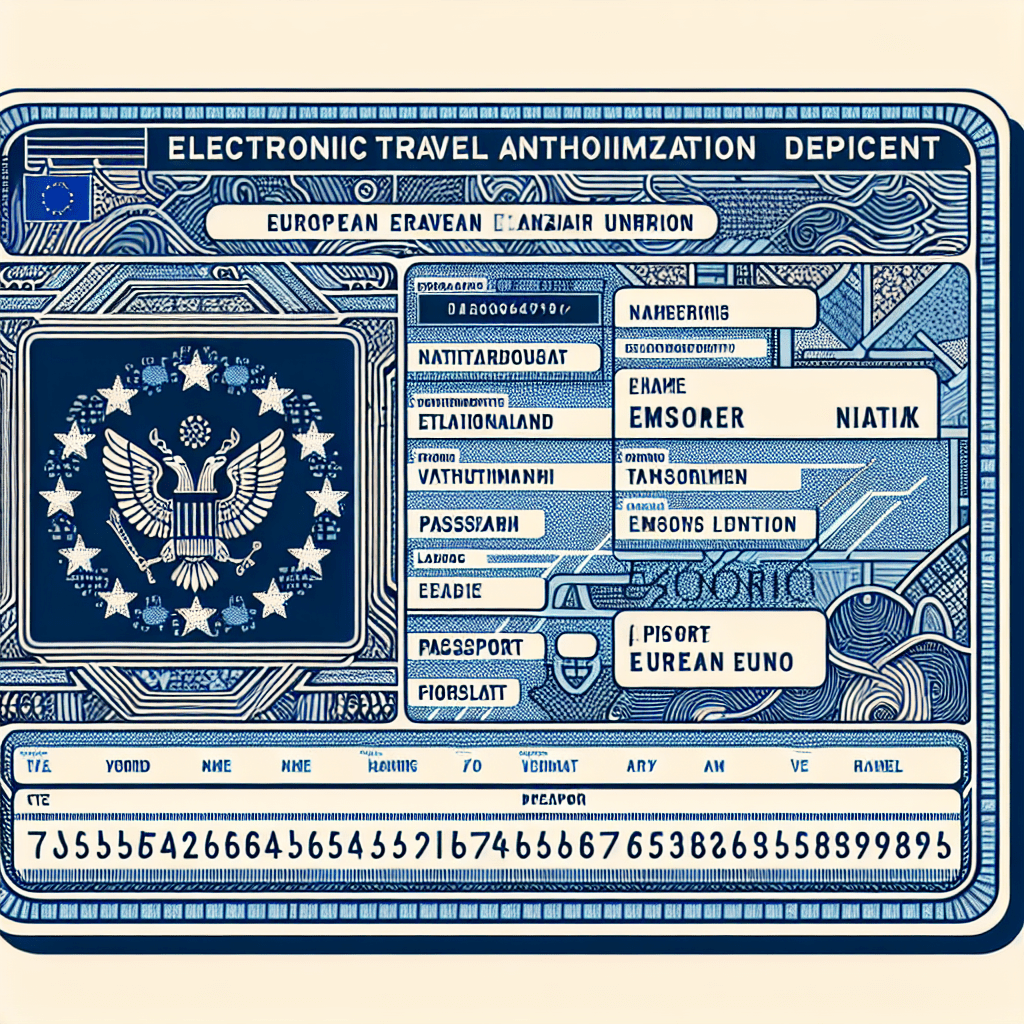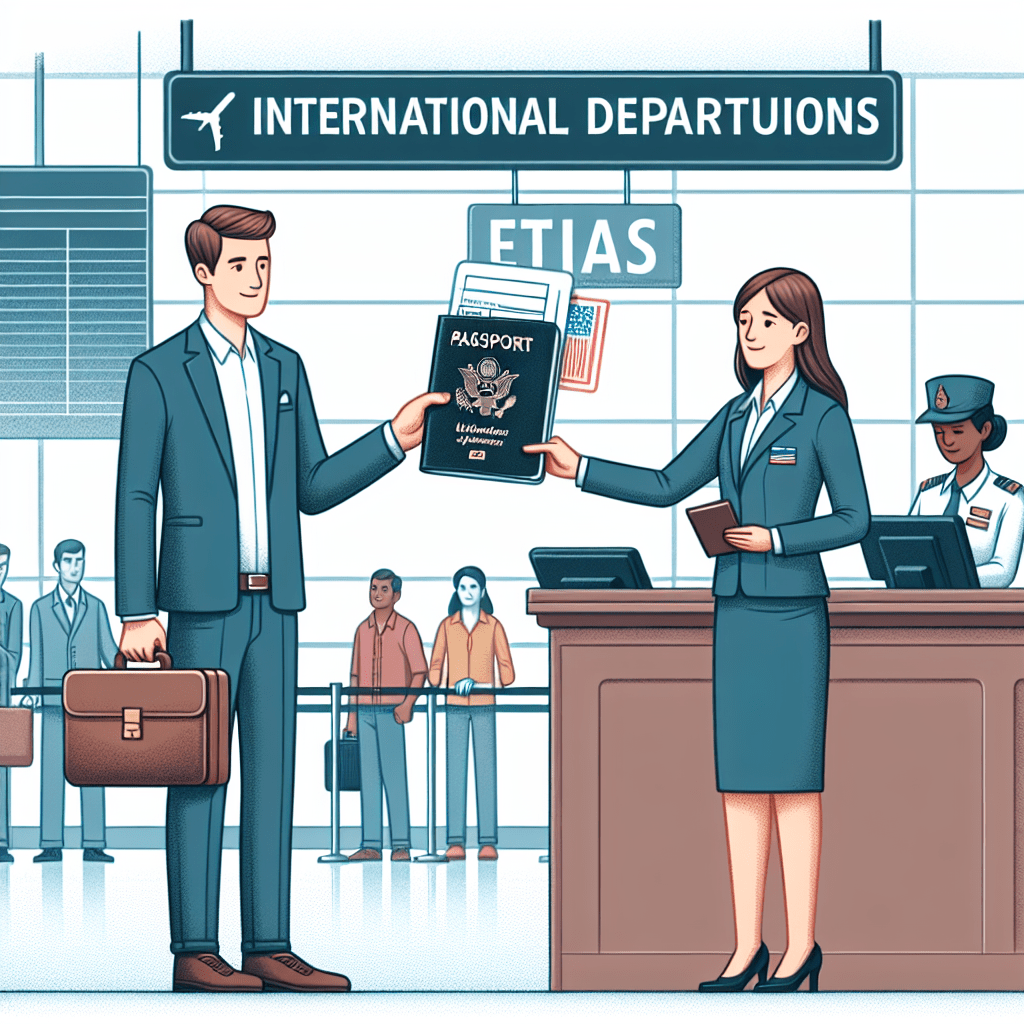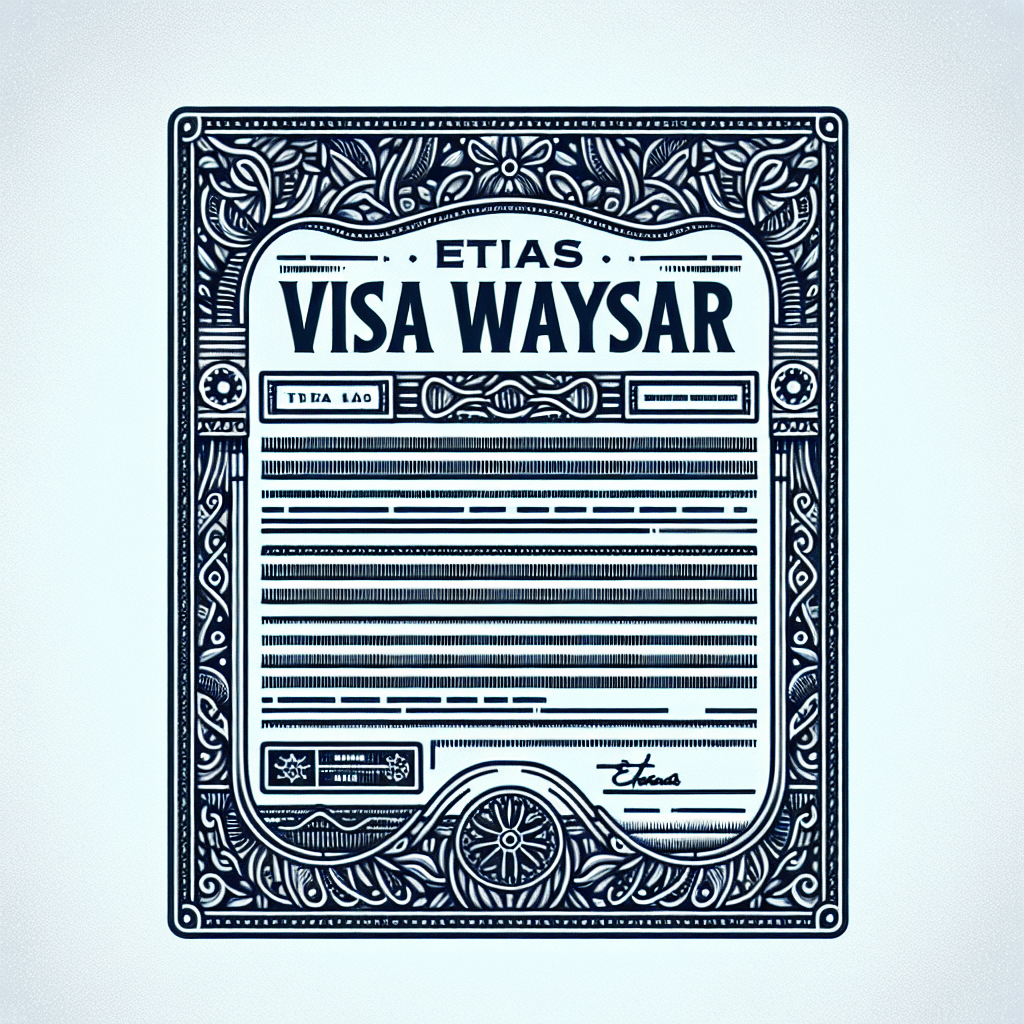10 Frequently Overlooked Facts About ETIAS

ETIAS, the European Travel Information and Authorization System, represents a significant shift in how travelers from visa-exempt countries gain entry to the European Union. Designed to enhance security and streamline border control, ETIAS requires eligible travelers to obtain travel authorization before visiting Europe. Unlike a traditional visa, ETIAS functions as a pre-screening tool, allowing authorities to assess potential risks and ensure safer travel across member states. This new system impacts millions of travelers, especially those from countries that previously enjoyed visa-free access to the Schengen Area.
Understanding ETIAS is crucial for anyone planning a trip to Europe, as it affects the entry process and travel planning. Many travelers remain unaware of the specific requirements, application procedures, and the scope of ETIAS, which can lead to confusion or delays at the border. The ETIAS travel authorization is not just a formality; it is a mandatory step that must be completed online before departure. Failure to obtain ETIAS approval can result in denied boarding or refusal of entry upon arrival, making it essential to be well-informed.
Beyond the basic knowledge of ETIAS, there are several frequently overlooked facts that can significantly impact travelers’ experiences. These lesser-known details range from the nuances of the ETIAS application process to the implications of ETIAS approval times and the validity period of the travel permit. For example, many travelers do not realize that ETIAS approval is typically granted quickly but should still be applied for well in advance to avoid last-minute complications. Additionally, the ETIAS system integrates with existing border control measures, enhancing security without imposing excessive burdens on legitimate travelers.
Highlighting these often-missed facts about ETIAS helps travelers prepare more effectively and avoid common pitfalls. Whether it’s understanding the specific ETIAS requirements Europe enforces or knowing how ETIAS interacts with other travel documents, being informed can make the difference between a smooth journey and unexpected obstacles. For those seeking detailed guidance on ETIAS and related travel authorizations, resources like ETIAS provide comprehensive support and up-to-date information to ensure compliance and ease of travel.
As ETIAS continues to shape the future of European travel, staying ahead of the curve by knowing these critical facts will empower travelers to navigate the system confidently. This knowledge not only facilitates hassle-free entry but also contributes to the broader goal of maintaining secure and efficient borders across the European Union.

ETIAS Application Process and Eligibility
Who needs to apply for ETIAS
The ETIAS travel authorization system applies primarily to travelers from visa-exempt countries who plan to visit the European Union’s Schengen Area. This group includes citizens from nations such as the United States, Canada, Australia, Japan, and many others that previously enjoyed visa-free access to Europe. While these travelers do not require a traditional visa, ETIAS mandates that they obtain an electronic travel authorization before their trip. This new requirement aims to enhance security and streamline border control by pre-screening travelers prior to arrival.
Visa-exempt travelers must apply for ETIAS regardless of the purpose of their visit, whether it is tourism, business, or transit. The system covers short stays of up to 90 days within any 180-day period. This means that even frequent travelers or business visitors who regularly cross European borders must secure ETIAS authorization each time they plan a new trip. The requirement ensures that all travelers undergo a standardized security screening before entering the Schengen Area.
There are, however, some exemptions and special cases. For example, travelers who already hold a valid visa or residence permit issued by a Schengen member state are not required to apply for ETIAS. Additionally, certain diplomatic or official passport holders may be exempt based on bilateral agreements. It is important for travelers to verify their eligibility before applying, as these exceptions can vary depending on nationality and travel circumstances.
Frequent travelers and business visitors should be particularly mindful of ETIAS requirements Europe enforces. Since ETIAS authorization is valid for multiple entries over a period of up to three years, it offers convenience for those who travel regularly. However, each trip still requires compliance with ETIAS travel restrictions, including the 90-day limit within any 180-day timeframe. Understanding these rules helps avoid overstays and potential penalties at border control.
Application requirements and procedures
The ETIAS application process is designed to be straightforward and user-friendly, conducted entirely online through an official ETIAS online application portal. Applicants must complete a detailed form that collects personal information, travel details, and security-related questions. The process typically takes about 10 to 20 minutes to complete, making it accessible for most travelers.
Once submitted, the ETIAS application undergoes an automated security screening that cross-references multiple databases, including Interpol, Europol, and national security agencies. This screening helps identify potential risks such as criminal records, previous immigration violations, or security threats. In most cases, ETIAS approval time is very short, often granted within minutes or a few hours. However, some applications may require additional manual review, which can extend processing times up to several days.
Applicants must provide accurate and complete information to avoid delays or rejections. Required documentation includes a valid passport from a visa-exempt country, contact details, travel itinerary, and answers to security questions related to health, criminal history, and previous travel. It is important to note that ETIAS is not a visa; therefore, no physical visa sticker or stamp is issued. Instead, the authorization is electronically linked to the traveler’s passport.
The cost of obtaining ETIAS authorization is relatively low, intended to cover administrative expenses. As of the current regulations, the fee is set at a modest amount payable online during the application. Once approved, the ETIAS travel permit is valid for up to three years or until the passport expires, whichever comes first. This validity period allows multiple entries into the Schengen Area without the need to reapply for each trip, provided the traveler adheres to the 90-day stay limit.
Common misconceptions about ETIAS
One of the most widespread misconceptions about ETIAS is confusing it with a traditional visa. Unlike a visa, which often requires a lengthy application process, interviews, and physical documentation, ETIAS functions as a travel authorization or pre-screening system. It does not grant entry by itself but rather permits travelers to board transportation bound for Europe. Final admission is still subject to border control checks upon arrival.
Another common misunderstanding is equating ETIAS with other travel authorizations such as the U.S. ESTA (Electronic System for Travel Authorization). While both systems share similarities in purpose and function, ETIAS is specific to the European Union and has its own set of requirements, application procedures, and security protocols. Travelers should avoid assuming that approval under one system automatically applies to another.
It is also important to clarify that ETIAS approval does not guarantee entry into the European Union. The authorization allows travelers to present themselves at border control, but the final decision rests with immigration officers who assess compliance with ETIAS travel restrictions and other entry criteria. Factors such as insufficient funds, suspicious behavior, or incomplete documentation can still result in denied entry despite having ETIAS authorization.
Understanding these distinctions helps travelers approach ETIAS with realistic expectations and proper preparation. By recognizing ETIAS as a mandatory travel permit rather than a visa, applicants can better navigate the application process and avoid unnecessary confusion. Awareness of ETIAS requirements Europe enforces and the system’s role in border control contributes to smoother travel experiences and compliance with international regulations.

ETIAS Operational Details and Security Features
Automated security checks and data screening
The ETIAS travel authorization system relies heavily on automated security checks and comprehensive data screening to ensure that travelers entering the European Union meet strict safety standards. At the core of this process is the integration of ETIAS with multiple EU security databases, including those maintained by Europol, Interpol, and national law enforcement agencies. This interconnected network allows ETIAS to cross-reference applicant information against watchlists, criminal records, and other security alerts in real time.
Applicants provide personal data such as name, date of birth, passport details, and travel plans through the ETIAS online application. In some cases, biometric data may also be collected or linked through existing passport information to enhance identity verification. The purpose of gathering this data is to create a robust profile that can be analyzed for potential security risks, including terrorism, organized crime, or irregular migration attempts. This preemptive screening helps prevent individuals who pose threats from entering the Schengen Area.
ETIAS security screening is designed to be efficient, with most applications processed within minutes. However, when the system detects potential concerns or inconsistencies, the application is flagged for manual review by security experts. This additional scrutiny can extend ETIAS approval time but is essential for maintaining the integrity of the system. The balance between rapid processing and thorough security checks ensures that legitimate travelers receive timely authorization while minimizing risks to the European Union.
ETIAS and its role in enhancing border security
ETIAS plays a pivotal role in strengthening border security across the European Union by acting as a proactive measure against irregular migration and criminal activities. By requiring visa-exempt travelers to obtain an ETIAS travel permit before arrival, authorities gain the ability to identify and intercept potential threats early in the travel process. This pre-screening reduces the burden on border control officers and enhances the overall safety of the Schengen Area.
Collaboration with law enforcement agencies is a key component of ETIAS’s effectiveness. The system shares data with national and international security bodies, enabling coordinated responses to emerging threats. This cooperation extends beyond simple data exchange; it includes joint efforts to track suspicious individuals, prevent human trafficking, and combat terrorism. ETIAS thus serves as a critical tool in the broader security framework of the European Union.
Data protection and privacy compliance are fundamental to ETIAS operations. The system adheres strictly to EU data protection laws, including the General Data Protection Regulation (GDPR), ensuring that personal information is handled securely and transparently. Travelers’ data is stored only as long as necessary for security purposes and is protected against unauthorized access. This commitment to privacy helps maintain public trust while balancing the need for effective security screening.
Impact on airport and border control operations
The introduction of ETIAS has a significant impact on airport and border control operations throughout the European Union. By requiring travelers to obtain authorization before arrival, ETIAS streamlines passenger flow at entry points. Border officers can focus on verifying ETIAS travel documents electronically, reducing the time spent on manual checks and minimizing queues during peak travel periods.
Despite these benefits, the initial implementation phases of ETIAS may present challenges. Airports and border control agencies need to adapt to new procedures and integrate ETIAS verification into their existing systems. Training personnel and updating technology infrastructure are necessary steps to ensure smooth operations. During this transition, travelers may experience occasional delays or confusion, underscoring the importance of clear communication and public awareness campaigns.
Overall, ETIAS enhances the travel experience by providing a more predictable and secure entry process. The system’s ability to pre-screen travelers reduces the likelihood of last-minute refusals at the border, allowing airlines and passengers to plan with greater confidence. As ETIAS becomes fully operational, it is expected to contribute to safer, more efficient travel across the European Union, benefiting both travelers and border authorities alike.

Practical Tips and Lesser-Known Traveler Considerations
Timing and renewal of ETIAS authorization
Proper timing is essential when applying for ETIAS travel authorization to ensure a smooth travel experience. It is recommended that travelers submit their ETIAS online application well in advance of their planned departure date. Although the ETIAS approval time is generally quick—often within minutes or a few hours—applying at least 72 hours before travel provides a buffer in case additional security screening is required. This precaution helps avoid last-minute complications that could disrupt travel plans.
Once approved, the ETIAS travel permit is valid for up to three years or until the traveler’s passport expires, whichever comes first. This validity allows multiple entries into the Schengen Area without the need to reapply for each trip, provided the traveler adheres to ETIAS travel restrictions, such as the 90-day limit within any 180-day period. Frequent travelers, including business visitors and tourists, benefit from this extended validity, as it simplifies the process and reduces administrative burdens.
Renewing ETIAS authorization is straightforward but must be done before the current authorization expires. Travelers should monitor the expiration date carefully and submit a new ETIAS application if they plan to continue visiting Europe. It is important to note that each application undergoes the same security screening process, so renewal is not automatic. Additionally, if a traveler’s passport changes or is renewed, a new ETIAS application is required since the authorization is electronically linked to the passport number.
In cases where an ETIAS authorization is revoked or expires during travel, the traveler may face difficulties at border control. Revocation can occur if new information arises that affects the traveler’s eligibility or security status. To avoid such issues, travelers should keep their personal information up to date and comply with all ETIAS requirements Europe enforces. Being proactive about timing and renewal ensures uninterrupted travel and compliance with European Union regulations.
Addressing technical and support issues
While the ETIAS application process is designed to be user-friendly, technical issues can occasionally arise during the ETIAS online application. Common problems include website accessibility, difficulties uploading documents, or errors in data entry. Travelers encountering such issues should first verify their internet connection and browser compatibility, as these factors often resolve minor glitches.
If problems persist, official ETIAS support resources are available to assist applicants. These include help desks, FAQs, and customer service contact points provided by the European Union and authorized service providers. Utilizing these resources promptly can prevent delays in ETIAS approval time and reduce stress associated with the application process.
Travel agencies and visa assistance services also play a valuable role in supporting travelers through the ETIAS application process. These professionals offer guidance on completing the application accurately, gathering necessary documentation, and understanding ETIAS travel restrictions. For US citizens and other visa-exempt travelers unfamiliar with European travel regulations, such services can be particularly helpful in navigating the new system efficiently.
Choosing reputable assistance providers ensures that travelers receive accurate information and avoid scams or fraudulent services. It is advisable to rely on official or well-established agencies that specialize in ETIAS and European travel permits. This support network contributes to a smoother application experience and greater confidence in meeting ETIAS requirements Europe enforces.
Effect of ETIAS on future travel planning
ETIAS represents a significant development in the landscape of international travel, with long-term implications for non-EU travelers planning trips to Europe. By introducing a mandatory pre-travel authorization, the European Union aims to enhance security while facilitating legitimate travel. This shift requires travelers to incorporate ETIAS into their travel planning well in advance, ensuring compliance with new regulations.
ETIAS also integrates with other European travel schemes, such as the Schengen visa system and national visa waiver programs. This integration creates a more cohesive and secure framework for managing cross-border movement. Travelers who previously relied solely on ETIAS visa waiver status must now consider the broader context of European travel documents and entry permits when organizing their itineraries.
In the post-pandemic era, ETIAS fits into evolving travel regulations that emphasize health security alongside traditional border control measures. The system’s electronic nature allows for rapid updates and adaptations to changing circumstances, such as new travel restrictions or health requirements. This flexibility benefits both travelers and authorities by maintaining efficient and safe travel corridors.
For US citizens and other frequent visitors, ETIAS offers predictability and convenience through its multi-year validity and streamlined application process. However, it also demands greater attention to detail and awareness of travel document requirements. Understanding how ETIAS interacts with other travel authorizations and border control procedures is essential for avoiding disruptions and ensuring a positive travel experience.
Ultimately, ETIAS encourages travelers to adopt a more proactive approach to international travel, emphasizing preparation and compliance. By recognizing the system’s role within the broader European Union security and travel framework, travelers can better navigate future trips and adapt to ongoing changes in global mobility.

Understanding ETIAS: Key to Seamless Travel Across Europe
Being well-informed about ETIAS is essential for anyone planning to travel to the European Union. As a mandatory travel authorization for visa-exempt travelers, ETIAS represents a fundamental change in how entry into the Schengen Area is managed. Awareness of ETIAS requirements Europe enforces, the application process, and the system’s security features can prevent unexpected delays or refusals at border control. Travelers who take the time to understand the nuances of ETIAS—such as eligibility criteria, validity periods, and the distinction between ETIAS and traditional visas—are better equipped to navigate the complexities of modern European travel.
ETIAS is not merely a bureaucratic hurdle; it is a critical component of the European Union’s efforts to enhance border security while facilitating legitimate travel. By obtaining ETIAS travel authorization in advance, travelers demonstrate compliance with new regulations and contribute to safer, more efficient border operations. This proactive approach reduces the risk of last-minute complications and helps maintain the integrity of the Schengen Area’s open borders. Informed travelers can plan their trips with confidence, knowing they have met all necessary requirements and can expect a smoother entry experience.
Moreover, understanding ETIAS helps travelers avoid common misconceptions that can lead to confusion or errors. For example, recognizing that ETIAS is not a visa but a travel permit linked electronically to a passport clarifies expectations and streamlines preparation. Being aware of the application timeline, renewal process, and potential security screenings ensures that travelers remain compliant and ready for any eventuality. Ultimately, knowledge about ETIAS empowers travelers to take control of their journey and reduces the likelihood of disruptions caused by incomplete or inaccurate information.
Utilizing reliable resources is equally important for a smooth European travel experience. Official platforms and trusted service providers offer up-to-date information on ETIAS application procedures, fees, and eligibility. These resources can guide travelers through the ETIAS online application, help resolve technical issues, and provide clarity on travel restrictions and border control policies. For US citizens and other visa-exempt travelers unfamiliar with European travel regulations, accessing accurate and comprehensive support is invaluable.
Travel agencies and visa assistance services specializing in ETIAS can further simplify the process by offering expert advice and personalized assistance. Leveraging these services reduces the risk of errors and ensures that applications are completed correctly and submitted on time. Additionally, staying informed through official channels helps travelers keep pace with any changes in ETIAS requirements or European Union travel policies, especially in a dynamic global environment.
In conclusion, being well-informed about ETIAS and utilizing dependable resources are key strategies for anyone seeking to travel to Europe without unnecessary complications. This knowledge not only facilitates compliance with ETIAS travel restrictions but also enhances overall travel confidence and convenience. As ETIAS becomes an integral part of European travel, embracing these practices will help travelers enjoy seamless, secure, and enjoyable journeys across the European Union.